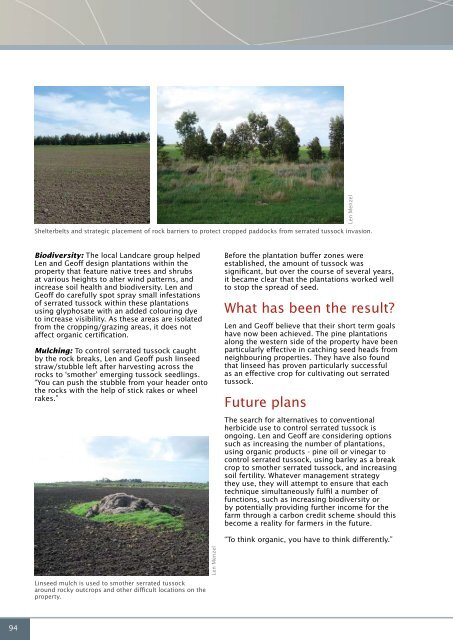Section 5 Case studies - Weeds Australia
Section 5 Case studies - Weeds Australia
Section 5 Case studies - Weeds Australia
Create successful ePaper yourself
Turn your PDF publications into a flip-book with our unique Google optimized e-Paper software.
Shelterbelts and strategic placement of rock barriers to protect cropped paddocks from serrated tussock invasion.<br />
Biodiversity: The local Landcare group helped<br />
Len and Geoff design plantations within the<br />
property that feature native trees and shrubs<br />
at various heights to alter wind patterns, and<br />
increase soil health and biodiversity. Len and<br />
Geoff do carefully spot spray small infestations<br />
of serrated tussock within these plantations<br />
using glyphosate with an added colouring dye<br />
to increase visibility. As these areas are isolated<br />
from the cropping/grazing areas, it does not<br />
affect organic certification.<br />
Mulching: To control serrated tussock caught<br />
by the rock breaks, Len and Geoff push linseed<br />
straw/stubble left after harvesting across the<br />
rocks to ‘smother’ emerging tussock seedlings.<br />
“You can push the stubble from your header onto<br />
the rocks with the help of stick rakes or wheel<br />
rakes.”<br />
Before the plantation buffer zones were<br />
established, the amount of tussock was<br />
significant, but over the course of several years,<br />
it became clear that the plantations worked well<br />
to stop the spread of seed.<br />
What has been the result?<br />
Len and Geoff believe that their short term goals<br />
have now been achieved. The pine plantations<br />
along the western side of the property have been<br />
particularly effective in catching seed heads from<br />
neighbouring properties. They have also found<br />
that linseed has proven particularly successful<br />
as an effective crop for cultivating out serrated<br />
tussock.<br />
Future plans<br />
The search for alternatives to conventional<br />
herbicide use to control serrated tussock is<br />
ongoing. Len and Geoff are considering options<br />
such as increasing the number of plantations,<br />
using organic products - pine oil or vinegar to<br />
control serrated tussock, using barley as a break<br />
crop to smother serrated tussock, and increasing<br />
soil fertility. Whatever management strategy<br />
they use, they will attempt to ensure that each<br />
technique simultaneously fulfil a number of<br />
functions, such as increasing biodiversity or<br />
by potentially providing further income for the<br />
farm through a carbon credit scheme should this<br />
become a reality for farmers in the future.<br />
“To think organic, you have to think differently.”<br />
Len Menzel<br />
Len Menzel<br />
Linseed mulch is used to smother serrated tussock<br />
around rocky outcrops and other difficult locations on the<br />
property.<br />
94

















